by W.F. Andelt, S.N. Hopper* (3/16)
Quick Facts…
- Three species of prairie dogs occur in Colorado.
- Prairie dogs and their burrows serve as important hosts for numerous other animals.
- Prairie dogs can damage rangeland and occasionally harbor plague.
- Control problem prairie dogs by relocation, visual barriers, shooting, poison grain bait, and fumigation.
- Elimination of prairie dogs does not guarantee the recovery of productive rangeland. Additional efforts must be taken to restore the affected range and grasslands.
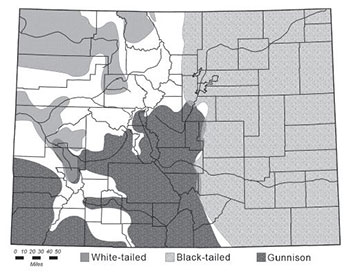
Figure 1: Distribution map of the three species of prairie dogs in Colorado1 |
Prairie dogs occupy an estimated two million acres in North America. Three species of prairie dogs are found in Colorado. The black-tailed prairie dog (Cynomys ludovicianus) lives on the eastern plains, Gunnison’s prairie dog (Cynomys gunnisoni) in the southwestern third of the state, and the white-tailed prairie dog (Cynomys leucurus) in the northwestern third of the state.
Prairie dogs are relatively large burrowing ground squirrels that weigh 1-1/2 to 3 pounds and are 14 to 17 inches long. Prairie dogs have reddish tan fur, large eyes, short ears and broad, rounded heads.
Biology and Social Organization
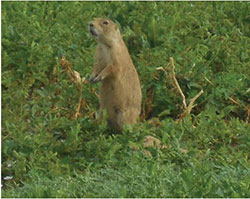
Figure 2: Black tailed prairie dog |

Figure 3: Black tailed prairie dogs |
Prairie dogs form colonies commonly referred to as prairie dog towns. Coteries, small groups within the town, are generally composed of one adult male, three adult females and six offspring. Prairie dogs within a coterie defend their territory within the larger town. They live in burrows about 10 yards apart, 3 to 14 feet deep, and 10 to more than 100 feet long. A mound 3 to 10 feet across and 6 to 12 inches high at the entrance of the burrow prevents water from rushing in and serves as a lookout station. A density of 35 black-tailed prairie dog mounds per acre is common, although up to 95 mounds have been reported. Burrow systems have one to three entrances. Black-tailed prairie dog numbers vary from about five per acre in late winter to 20 per acre after the birth of pups in spring. Prairie dog spring densities can be as high as 35 animals per acre.
Prairie dogs are active only during the day. White-tailed and Gunnison’s prairie dogs hibernate from about October to March, depending on elevation. Black-tailed prairie dogs do not hibernate, but will stay below ground for several days during cold cloudy weather. They have one litter of three to eight young per year in March or April. The gestation period is 28 to 34 days. Pups venture above ground when they are five to six weeks old. Dispersal of year-old juveniles and a few adults takes place in late spring. Most prairie dogs travel less than two miles, but a few may move up to six miles.
Effects on Rangeland
The role of prairie dogs in reducing available range forage for livestock is not well studied. Several factors can influence forage reduction, including geographic location, rainfall, dominant grass species and duration of prairie dog habitation. Recent research suggests effects ranging from 20 to 30 percent less forage to an increase in the percentage of grass species preferred by livestock.
Ecological and Economic Importance
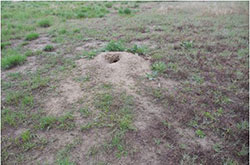
Figure 4: Prairie dog mound and burrow |
Prairie dog burrows serve as homes for burrowing owls, cottontail rabbits, rattlesnakes and other animals. In Oklahoma, 89 vertebrate species were associated with prairie dog towns. Prairie dogs are a major food source for predators, including the endangered black-footed ferret, badgers, coyotes, foxes, prairie falcons, ferruginous hawks, and eagles.
The burrowing activity of prairie dogs provides the greatest ecological benefit by decreasing soil compaction, increasing water intake, aerating the soil and promoting soil formation. Their foraging vegetation and clipping activities can alter the vegetation in the colony by favoring certain grass and forb species. Grass species favored by prairie dogs include western wheatgrass, buffalograss and grama grasses. Prairie dogs also provide recreation for photographers, hunters, and naturalists.
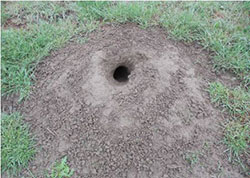
Figure 5: Prairie dog mound and burrow |
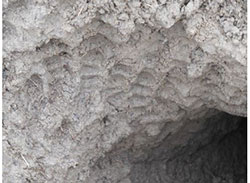
Figure 6: A crater mound formed in moist soil. Note the nose prints made in side of mound when the prairie dog compacted the soil. |
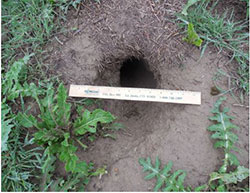
Figure 7: Weedy area around mound where previously existing vegetation was removed by the prairie dogs. |
Health Risks
Prairie dogs are hosts for fleas, making them susceptible to plague. Plague may be transmitted to humans via flea bites. Early symptoms of plague include swollen and tender lymph nodes, chills and fever. Early diagnosis and treatment is imperative. When walking through suspected plague areas apply an insect repellent to socks and pant cuffs before tucking pants inside boots.
Black-Footed Ferrets
It is illegal to kill a black-footed ferret, an endangered species that feeds almost exclusively on prairie dogs. It is estimated that one female ferret and her young require about 200 prairie dogs for food per year.
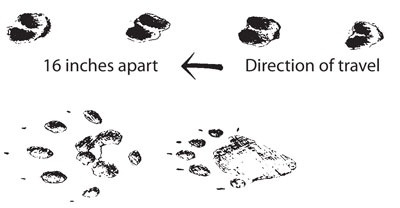
Figure 8: Ferret tracks. Top: in the snow. Bottom: Front and back feet. Illustration by Vivian Drewien. |
The black-footed ferret weighs 1 1/2 to 3 pounds and is 21 to 23 inches long. It has a black mask, black feet and legs, and a black-tipped tail. Sides are a pale yellow buff that is lighter toward the underside of the body. The forehead, muzzle and throat are almost white, whereas the top of the head and middle of the back are brown.
Do not confuse the black-footed ferret with the European ferret, which has longer and darker fur on the back with an entirely black tail; the mink, which usually is uniformly dark brown; or the long-tailed weasel, which is smaller and has a chocolate brown body with pale yellow underside.
Black-footed ferrets seldom are observed because they occur in low densities and primarily are active at night. However, their presence can be determined by the occurrence of ramps or ferret tracks (Figure 8).
Notify Colorado Parks and Wildlife or the U.S. Fish and Wildlife Service when black-footed ferrets are present.
Black-Footed Ferret Surveys
A black-footed ferret survey, following U.S. Fish and Wildlife Service guidelines, is required in most areas before aluminum phosphide tablets and gas cartridges can be used for prairie dog control.
Conduct the survey between July 1 through October 31 and less than 30 days before using a fumigant. Work at night using spotlights. Surveys can be conducted by biologists trained in black-footed ferret survey techniques. For a list of certified biologists, contact the U.S. Fish and Wildlife Service in Grand Junction at (970) 243-2778 or Denver at (303) 275-2370.
A landowner may be exempt from the survey if any of the following conditions exist: a survey was conducted and no ferrets were found; there are less than 80 acres occupied by black-tailed prairie dogs or 200 acres occupied by white-tailed prairie dogs within a 4.3 mile radius of the control site; or the control is conducted in an urban area.
Management Methods
Several alternatives for prairie dog management are available, including trapping, barriers, shooting, using poison baits, and using fumigants (poison gas).
Relocation
The biggest obstacle to prairie dog relocation is finding release sites. A permit is required before prairie dogs can be relocated. Contact your nearest Colorado Parks and Wildlife office to start the process.
Trapping and Barriers
Prairie dogs can be captured with double-door cage traps baited with a horse sweet feed mix, flushed from burrows with soap and water, or removed from burrows with a large vacuum truck. All three methods are expensive and their long-term effectiveness is largely unknown. Survival of prairie dogs flushed from burrows and those relocated to active towns also is unknown. However, releasing prairie dogs into an established colony likely will increase stress on resident and relocated prairie dogs.
Shooting
Intensive shooting of small prairie dog colonies during February and March will sometimes manage populations. It disrupts reproductive activities and removes individual animals. Follow good hunter safety practices and local regulations when using shooting as a management tool. Shooting may induce bait shyness.
Rodenticide safety
When dealing with any rodent problem, utilize all management techniques to resolve the problem and do not rely solely on rodenticides. Set realistic goals such as minimizing the rodent number on your property by using exclusion methods and eliminating desirable habitat or food sources. You’ll never eliminate all prairie dogs. When using any rodenticide always read and follow the label and guidelines and be sure you understand them prior to use to minimize off target (i.e. raptors, dogs, and cats) poisoning.
Rodenticides are meant to kill rodents but will also kill other animals if used improperly. Western Burrowing Owls are commonly found in prairie dog towns throughout Colorado. With the restoration of endangered Black-footed Ferrets, it is critical that properties are surveyed for their presence prior to any rodenticide application. Fines and tickets can be assessed for causing the deaths of these endangered animals.
Steps for safe use of rodenticides
-
- Positively identify the pest and determine all techniques that can be used to deter the pest such as habitat modification and exclusion.
- Choose the most effective, least toxic rodenticide to minimize potential non-target poisoning.
- If you choose to use a rodenticide:
- Read and follow the label.
- Abide by any limitation of use (for example: use only between Nov. 1 and March 30) and other label restrictions
- Wear proper protective clothing and equipment.
- Don’t smoke or eat while mixing or applying a rodenticide, and wash thoroughly after application.
- Mix and apply only the quantity you need.
- Always store rodenticides away from pets, children and wildlife.
- Always locate rodenticides so that off-target species cannot access them (for example: children, pets, wildlife). Use enclosed bait boxes or make sure rodenticide is deposited deep in the tunnel or locate rodenticides in locked areas inaccessible to children, pets or wildlife.
- Never store rodenticides near food items for human, pet or livestock.
- Follow the label instructions on carcass surveillance.
Reference: EPA Citizen’s Guide to Pesticide Safety http://www.epa.gov/safepestcontrol/citizens-guide-pest-control-and-pesticide-safety
Poison Baits and Fumigants
Several different types of pesticides can be used for prairie dog control in Colorado, including grain baits and products that generate poison gases (fumigants). All of these products are federally restricted use pesticides, except for the USDA gas cartridge. Landowners who plan to do their own control must have a valid private pesticide applicator license from Colorado Department of Agriculture [(303) 869-9063] before purchase or use of a restricted use pesticide. Landowners can also hire a commercial applicator. Commercial applicators must be licensed in the ‘outdoor vertebrate’ category.
For each product used, the applicator must read and follow the written directions and restrictions provided with the product. Label requirements change with time and differ among products. The information below does not provide complete instructions, and is not a substitute for the label directions that came with the product to be used.
Many other species of wildlife can occupy prairie dog burrows. All prairie dog poisoning or gassing operations should be preceded by carefully examining each burrow prior to treatment to make sure it is being actively used by prairie dogs and is not occupied by any other species of wildlife. Applicators should read and follow the additional label guidance to minimize risk to non-target wildlife at: http://cpw.state.co.us/Documents/WildlifeSpecies/SpeciesOfConcern/BlackTailedPrairieDog……
Poison Grain Baits
Two types of poison grain baits can be used for prairie dog control in Colorado: zinc phosphide baits, and those containing an anticoagulant poison. All poison grain baits for prairie dog control are restricted use pesticides, due to the hazard to other species of animals. Many of the restrictions and limitations on use are necessary to prevent death or injury to non-target birds and mammals, including wildlife, pets, and livestock. These baits can only be used for prairie dogs on rangeland, rangeland and pasture, or rangeland and adjacent non-crop areas (depending on the specific product label).
Poison grain baits are effective only when the prairie dogs’ most desirable food, green grass, has become dry and dormant. Fall baiting generally is most successful because prairie dogs eat grass seeds to build fat reserves for the winter.
Baits Containing Zinc Phosphide
Several oat baits containing 2% zinc phosphide are available for use in Colorado (e.g. ZP AG Oats™, Prozap zinc phosphide oat bait™, and USDA’s zinc phosphide on oats). Zinc phosphide is stable in dry conditions, but reacts slowly with water (including atmospheric moisture) to form phosphine gas. When ingested by prairie dogs, it reacts quickly with stomach acids to release phosphine gas, which is quickly lethal to the prairie dog.
Zinc phosphide application is restricted to July 1 through early winter, with the specific end-date varying among products (end of January or February). It is most successful when applied between September and November. Gunnison’s prairie dog and white-tailed prairie dog hibernate during winter months. The species found on the eastern prairie and along the Front Range, the black-tailed prairie dog, does not hibernate, but is most active on warm sunny days. Baiting should only occur when prairie dogs are active. Some zinc phosphide will be lost as phosphide gas if exposed to rainfall or other moisture, so baiting should occur only during settled weather.
Pre-baiting with steamed crimped oats one to two days prior to baiting is required for all zinc phosphide baits. When first exposed to the bait, prairie dogs may take a small taste, which will result in a rapid, acute adverse effect. A prairie dog that survives this initial exposure will become ‘bait-averse’ and won’t attempt to feed on such bait again. Pre-baiting is essential for getting a lethal amount of bait consumption and to prevent bait aversion. Some products restrict applications to rangeland to areas with less than 50% ground cover.
To pre-bait, apply the untreated oats by hand on the edge of each mound where bare soil meets grass or to adjacent feeding areas. Do not place bait on top of the mound or down the burrow. Be sure to monitor bait consumption. This is also a good time to monitor for non-target wildlife. If bait is not consumed after one day, postpone application or use another method of prairie dog control.
Do not apply poison bait in areas inhabited by livestock and do not graze animals in treated areas. Applicators must wear waterproof gloves. Some product labels require a respirator. Apply one teaspoon (4 grams) of zinc phosphide bait per mound. Thinly scatter the treated bait in a 6-inch bait spot, preferably during early morning. Avoid placing treated bait in piles. Apply only to burrows where the untreated bait was consumed.
A typical prairie dog town requires about 1/3 pound of zinc phosphide bait per acre. Application of excess bait will not improve control but will increase the risk to non-target animals. Only apply poison grain bait once per season. (Survivors of the first attempt will be bait-shy.)
Check for and dispose of any spilled or unused bait or observed animal carcasses. Wear waterproof gloves when retrieving carcasses or unused bait. Retrieved bait or animal carcasses can be disposed of by burying at least 18 inches deep.
Preferably purchase only the amount needed per application. Store bait according to the label and only in original container, in a dry place inaccessible to children, pets and domestic animals.
When poison grain baits are applied according to directions, they usually result in an 80 to 90 percent reduction in prairie dog numbers. Unsuccessful control generally is due to the presence of green grass or failure to pre-bait.
Baits Containing Anticoagulants: Chlorophacinone (Rozol Prairie Dog Bait) or Diphacinone (Kaput-D Prairie Dog Bait)
Both Rozol™ and Kaput-D™ Prairie Dog Baits are federally restricted use pesticides. They can be used only for control of black-tailed prairie dogs on rangeland and adjacent noncrop areas. This species is found on the eastern plains of Colorado. It cannot be used on the species found west of the Front Range of Colorado (Gunnison’s prairie dog or white-tailed prairie dog).
There are now enforceable endangered species bulletins for anticoagulant prairie dog baits for several Colorado counties. You must check the EPA website to obtain any county bulletins no less than 6 months before applications are to occur. Product can only be applied between October 1 and March 15 of the following year. (In some counties, product cannot be applied until November 1; see endangered species protection bulletins for your county).
Apply ¼ cup (about 2 oz.) of bait at least 6 inches down active prairie dog burrows. Pre-baiting is not required for these anticoagulants baits. The toxic effect is slow-acting, so bait aversion will not occur. Do not allow livestock to graze in treated areas for 14 days after treatment and when no bait is found above ground.
The applicator must return to the site within 4 days after bait application, and at 1 to 2 day intervals hereafter, to collect and properly dispose of any bait or dead or dying prairie dogs found on the surface. Any dead or dying non-target species of animals must be reported as described on the product label. Continue to conduct these searches for at least 2 weeks, but longer if carcasses are still being found.
Carcass searches must be performed using a line-transect method that completely covers the baited area. Transect center lines must be 200 feet or less apart (less in more densely vegetated sites).
If prairie dog activity persists several weeks or months after the bait was applied, a second application of the same bait can be made. This follow-up application can also only occur between October 1 and March 15.
Fumigants
Two types of fumigants can be used for prairie dog control in Colorado: those containing aluminum phosphide or the USDA gas cartridge. Aluminum phosphide products are classified as restricted use pesticides and gas cartridges are classified for general use. Fumigants are most effective when used in moist soils in early spring. They are generally less effective in dry soil.
Fumigants will kill any other vertebrates that may be occupying a treated burrow, so burrows should be observed carefully to make sure they are not occupied by burrowing owls, black-footed ferrets, or other wildlife. Burrows occupied by burrowing owls can be identified by the white droppings, pellets and feathers found around the burrow opening. Do not treat burrows that show signs of occupation by other species. Only treat burrows that are in active use by prairie dogs.
For fumigants to be effective, every opening of each prairie dog burrow has to be covered to contain the poison gas. This makes fumigant application more labor intensive than bait application. However, baits require more follow-up, with post-application monitoring and collection of carcasses and unconsumed bait.
Fumigants are sometimes used as a follow-up to a bait application. In these cases, treating only active mounds can greatly reduce the amount of fumigant used. To identify active mounds, shovel or blade the soil or place a dry cow chip over all holes. Prairie dogs will unplug holes in areas where they are active. It is important to begin treatment the day after plugging holes because one prairie dog will uncover several holes in three or four days.
Aluminum Phosphide Fumigants
Trade names for aluminum phosphide products include PhostoxinTM, FumitoxinTM, PH3TM, and Weevil-cide,TM and most brands are available as both a pellet and a tablet. Products are sold in gas-tight, resealable aluminum flasks, with both a container label and an applicator’s manual. Aluminum phosphide reacts with atmospheric moisture to produce phosphine gas. Phosphine gas is highly toxic to insects, burrowing pests, humans, and other forms of animal life. It may also ignite spontaneously in air at concentrations above 1.8% volume/volume.
Use is prohibited on residential properties and nursing homes, schools (except athletic fields), daycare facilities and hospitals. It must not be applied into a burrow system that is within 100 feet of a building that is, or may be, occupied by humans and/or domestic animals.
Aluminum phosphide can be used for prairie dog control only on agricultural areas, orchards, non-crop areas (such as pasture and rangeland), golf courses, athletic fields, airports, cemeteries, rights-of-way, earthen dams, parks and recreational areas and other non-residential institutional or industrial sites. Pellets or tablets must be applied directly to underground burrow systems.
Prior to treatment, the applicator must prepare a fumigation management plan (FMP) for each fumigation treatment. See the applicator’s manual for a checklist of what must be included in each fumigation management plan. An FMP sample for burrowing rodents is also available at the Colorado Department of Agriculture website: https://ag.colorado.gov/fumigation-management-plans.
Examples of FMP’s may also be available from manufacturers. Commercial applicators must provide the customer with a copy of the FMP prior to treatment.
Applicators must post a sign at each application site containing the signal word DANGER/PELIGRO with skull and crossbones, the name and EPA registration number of the fumigant, and a 24 hour emergency response number. Signs may be removed 2 days after the final treatment. When used in athletic fields or parks, the signs must be posted at the entrances to the treated site.
Flasks should always be opened in open air because rarely they may flash upon opening. Invert the container several times then point the container away from the face and body and slowly loosen the cap. Never open these containers in a flammable atmosphere.
Applicators must wear dry gloves of cotton or other material if contact with tablets or pellets is likely. Gloves must remain dry during use. Aerate used gloves and other clothing that may be contaminated in a well-ventilated area prior to laundering.
Locate all entrances to each burrow system. Treat all entrances except for those entrances you are sure connect to already treated entrances. To use aluminum phosphide, insert 2 to 4 tablets or 10 to 20 pellets as far back into the burrow as possible. Use the lower rates for smaller burrows and/or when soil moisture is high. Pack the treated entrance with crumpled paper and shovel soil to completely cover the paper. The newspaper prevents the fumigant from being covered and may deter prairie dogs from digging out before they die. Rocks, clods of soil, cardboard, etc. may also be used. Be sure to seal all untreated entrances by shoveling or packing soil and/or sod to completely seal the opening.
Inspect treated area 1 to 2 days following treatment for signs of residual activity of prairie dogs. Treat all reopened burrow openings as described above.
Aluminum phosphide appears to provide the best control when soil temperatures are above 60 degrees F. It cannot be used at or below 40 degrees F. When applied properly, aluminum phosphide routinely provides greater than 90 percent control.
The phosphine gas produced by aluminum phosphide tablets is toxic to all forms of animal life. Exposure through inhalation produces symptoms such as a pressing sensation in the chest, dizziness, nausea, vomiting, and a rapid onset of stupor. Expose affected people to fresh air and provide immediate medical attention.
Transportation of aluminum phosphide is governed by the U.S. Department of Transportation rules and regulations regarding hazardous materials. These regulations are subject to change. If you have any questions call Hazmat (Colorado State Patrol Hazardous Materials Section) at (303) 273-1900.
These products must be stored in a dry, well-ventilated area away from heat, under lock and key. Post as a pesticide storage area. Do not store in buildings where humans or domestic animals reside.
Transportation Regulations
Place placards on all four sides of vehicle being used to transport fumigant.
Carry shipping papers containing the following information: proper shipping name (aluminum phosphide), hazard class/division number (4.3), material identification number (UN1397), packing group designation (PG 1), subsidiary hazards (poison 6.1 inhalation hazard), and amount of product in quantity and total gross weight.
Keep the aluminum phosphide in the original canister and box.
Keep a log book if transporting aluminum phosphide over 100 air miles. The log book is a record of duty for the day, recorded in 15 minute intervals. If transporting under 100 air miles, only a time record must be kept. This includes name of person transporting, date, time started on duty, and time going off duty.
Carry a fire extinguisher with a rating of 10B:C.
Prior to transporting aluminum phosphide, the driver must be satisfied that the vehicle is in safe operating order. At the end of the day that the material was transported, the driver must prepare a written inspection report. The following parts and accessories should be inspected and reported on: service brakes including trailer brake connections, parking (hand) brake, steering mechanism, lighting devices and reflectors, tires, horn, windshield wipers, rear vision mirrors, coupling devices, wheels and rims, and emergency equipment.
The report should identify the vehicle and list any defects or deficiencies found. If none are found the report should so indicate. Correct any defects or deficiencies before operating the vehicle again and note the corrections in the report. The report should be signed by the driver. Make two copies of the report. Keep one copy in the vehicle until the next time an inspection report is required, and keep one copy at the driver’s place of business for at least three months from the date the report was prepared.
In addition to these pre- and post-trip inspections, a more in-depth annual inspection is required. Information pertaining to this inspection may be obtained by calling Hazmat at (303) 273-1900.
Have $1,000,000 insurance if transporting aluminum phosphide in a vehicle with a greater than 10,000 pound gross vehicle weight rating or if transporting over a state line.
The driver must be over 21 years old.
USDA gas cartridge
The gas cartridge is the only pesticide for prairie dog control that is not a restricted use pesticide. Gas cartridges are ignited with a fuse and burn, producing smoke. Prairie dogs are killed primarily by the carbon monoxide produced. It can be used in open fields, non-crop areas, rangelands, reforested areas, lawns and golf courses.
Once ignited, cartridges will burn vigorously until completely spent. Burning cartridges are capable of causing severe burns, and can ignite dry grass, leaves and other combustible material. Do not use in or under buildings, near flammable material, or when either the soil or the vegetation in the area to be treated is extremely dry. Gas cartridges will not give satisfactory control if the soil is dry.
| The phosphine gas produced by aluminum phosphide tablets is toxic to all forms of animal life.
Do not use fumigants in burrows occupied by black-footed ferrets, burrowing owls, rabbits and other non-target wildlife. |
Locate and plug all entrances to the burrow system except the entrance selected for treatment, and have the material needed to plug this entrance ready. To use the gas cartridge, punch the fuse-end cap of the cartridge at the points marked with a nail at least 1/8” in diameter. Insert the fuse in the center hole of the cartridge, with at least 3 inches of fuse exposed. The minimum burn time for these fuses is 5 seconds.
Hold cartridge away from face and body, then light fuse. Once the fuse is burning well, place cartridge, fuse-end first, as far into the burrow as possible. Or gently roll the cartridge as far back into the burrow opening as possible.
Immediately plug the opening with moist soil or a plug of sod placed grass-side down to form an air-tight seal. Do not cover or smother the cartridge. Cover all cracks in soil where smoke escapes.
Vegetation Recovery after Extermination
Prairie dog extermination does not guarantee productive vegetation recovery. Additional steps must be taken to rehabilitate the vegetation in evacuated prairie dog towns.
To speed recovery, level mounds with a land plane, blade or offset disc set just above the ground surface. To allow the grass and root system recovery, exclude livestock from the area for at least one growing season, and reseed the area with grass.
Because prairie dogs do not thrive in tall grass, careful management of grass through proper stocking rates can discourage re-invasion by prairie dogs. Prairie dogs often establish colonies in areas where livestock congregates. To distribute grazing pressure evenly, move watering sites and place salt and minerals in areas that are underused by livestock.
Visual barriers constructed from burlap or windrows of small pine trees have slowed colony expansion. Barriers usually are constructed from a woven plastic material. The use of visual barriers is limited due to high construction and maintenance costs. Raptor perches, artificial cover for predators, and predator odors generally have been ineffective in reducing prairie dog numbers.
1Distribution Map: Redrawn based on Armstrong, David M., Fitzgerald, James P., and Meaney, Carron A., 2011. Mammals of Colorado 2nd ed.: Denver Museum of Nature & Science and University Press of Colorado.
*Original publication by W.F. Andelt, Colorado State University, professor emeritus, department of fish, wildlife and conservation biology; S.N. Hopper. Reviewed and updated (12/12) by Laura Quakenbush, Colorado Department of Agriculture and Colorado Division of Parks and Wildlife; Tina Jackson and Amy Seglund, Colorado Division of Parks and Wildlife. Reviewed and revised 3/16 by S. Bokan, Small Acreage Coordinator Boulder County; K. Crumbaker, Ag and Natural Resources Agent Larimer County; T. Hoesli, Extension County Director Grand County; D. Lester, Extension County Director Park County and I. Shonle, Extension County Director Gilpin County. (3/16).
Colorado State University, U.S. Department of Agriculture and Colorado counties cooperating. Extension programs are available to all without discrimination. No endorsement of products mentioned is intended nor is criticism implied of products not mentioned.
Go to top of this page.





